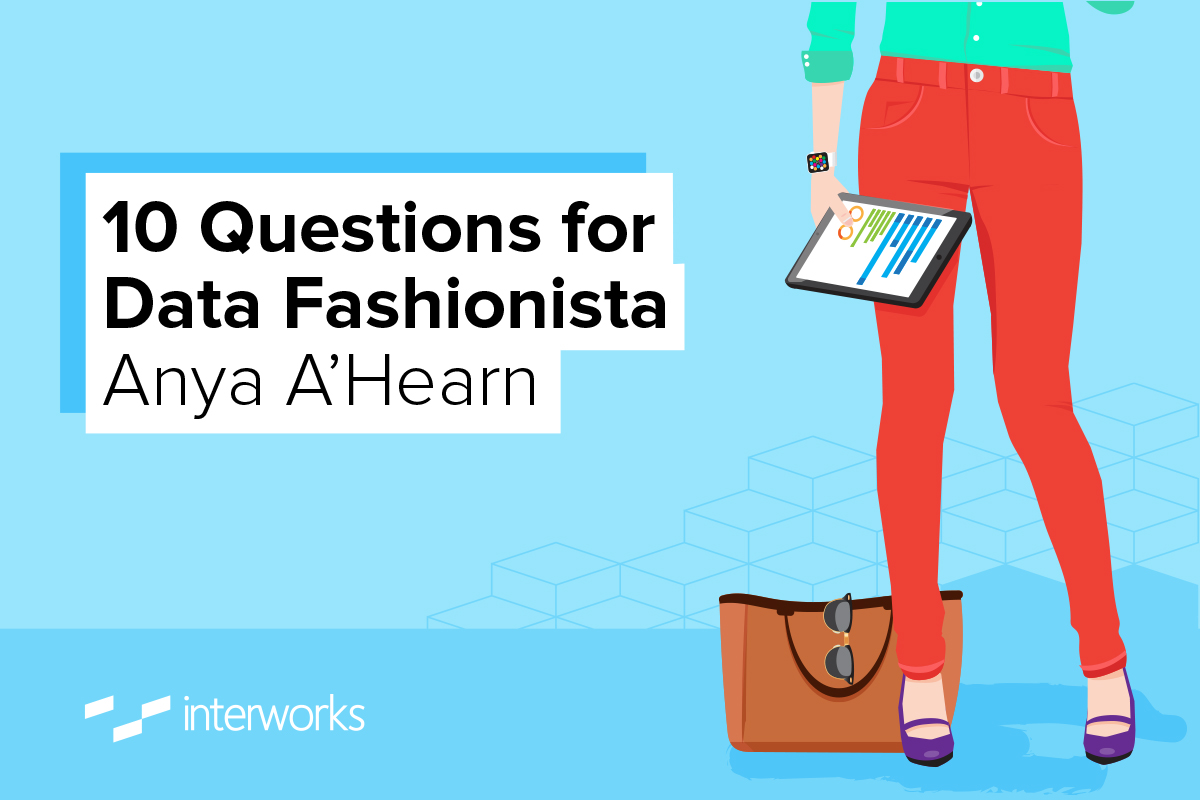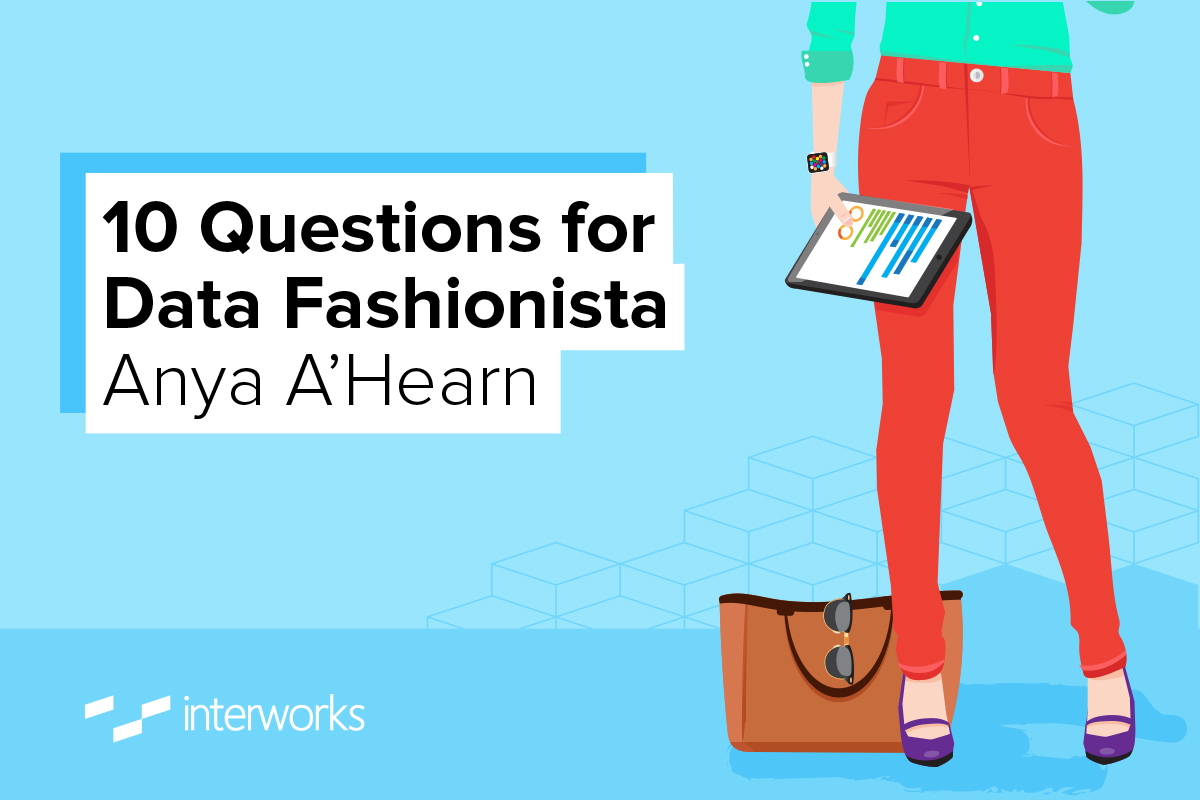10 Questions is an ongoing blog series in which Tableau Zen Master Dan Murray interviews some of the brightest folks in the world of data.

Somehow, I didn’t actually meet Anya in person until the conference in Washington, D.C., a few years ago. I knew of her and her work with Tableau well before then. Her personality in her blog posts is consistent with her personality in person. She is gregarious and funny — a real joy to be around. Based in San Francisco, she has her own consulting business called Datablick.
A’Hearn: Awww, thanks Dan. I’m so excited to be included in your interview series, that i’m gonna crank it past 11 and answer 12 questions!
The Questions
Q: Tell me about your professional background. When did you get started?
A’Hearn: I started as a business analyst for Lufthansa Airlines over 20 years ago for their Sales Department in New York and Frankfurt, Germany. I enjoyed the power of data to tell stories about sales performance, capacity planning and marketing effectiveness; I was excited to start using a tool called Cognos. I fell in love with slicing through data like butter, so I went to work for them as a technical trainer and consultant. Then, I worked for Brio for a bit. And after that, I took some time to earn a master’s in industrial design. I love to apply product design methodology to develop data products based on user needs and goals, building dashboards and applications that are minimalist, beautiful, impactful and a call to action. Merging my analytic and design sides, I started consulting at Visa, project managing an enterprise reporting product for Commercial Cards. We built reporting tools for clients like the Department of Defense and Wells Fargo.
Q: How and when did you discover Tableau?
A’Hearn: While on maternity leave with my first child, Max, I desperately needed my data fix and found a trial version of Tableau. Almost seven years later, i’m a certifiable junkie. I remember coming back to work and just watching jaws drop with the things I could do in 10 minutes that would take days to do in other tools. The merging of beautiful design and data just seemed like a perfect fit for me.
Q: Who has influenced your visualization style?
A’Hearn: I know you are looking for data viz peeps here, but I try to get most of my design cues from the art and fashion world. In my data viz style, I focus on the structure and composition of the piece as a whole. How do you control the eye movement of the user? You want them to create relationships, draw inferences and pop anomalies that require attention. You want to lay things out in a way that is pleasing to the eye, intuitive to consume and creates a response. I like to use techniques like implied lines, the rule of thirds and contrasting (often triptych) color values to create a dominant data story and draw the user through the flow of the dashboard. Once you have an understanding of classic solid construction, get a little punk rock with it. Have fun! .
Q: It’s not easy to make a living as an independent consultant. How do you organize your day/week?
A’Hearn: Well, DataBlick is not just me anymore. We are actually growing into quite the boutique “Data Viz Design” consulting company (specializing in Tableau of course). The amazingly brilliant Noah Salvaterra is now consulting via DataBlick, and Joe Mako is heading up our new “Tableau Personal Trainer” program, where you can schedule one-to-one sessions that are customized to help you solve the problems or deepen your knowledge. These training sessions cover anything from fundamentals – the concept of dimensions in Tableau, table calcs, level of detail, data blending, data densification – to working towards doing something that no one else has done before in Tableau. I think DataBlick is giving Slalom a run for their money in the “Number of Zen Masters” category now. 🙂
Q: Your recent blog post on Mapbox (with Craig Bloodworth and Alan Walker) really opened my eyes to the potential of creating custom maps easily. How do you see Mapbox enhancing Tableau’s mapping capabilities?
A’Hearn: Well, first off, it was Craig Bloodworth and Allan Walker who paved the way for all this fun, so huge props to them! I just got carried away with map styling mayhem and had to share the fun with the rest of the folks out there in Tableau Land with my “how to” posts on creating a custom background maps and adding switchable map layers.
How fun are Mapbox maps! Now I can have customized map data in the background and foreground of my analysis. Instead of just using the dual axis to squeeze custom shapes and as much as possible into my map foreground, I can leverage as many layers as I want in the background and toggle them on and off. Just a year ago, I had to set up my own web server to do this, and now, with a few clicks, I can have amazing custom maps with my custom shapes, styled the way I want. Yes, editing a few lines of code is a bit of a hassle, but it’s so worth the squeeze! Be sure to check out my and Allan’s session at the Tableau Conference this year on how to create custom maps in Mapbox.
Next steps: I’m looking forward to exploring real-time Mapbox layers as well as trying to get interactions in the foreground to affect the map layers in the background Mapbox layers. I’m thinking there will be a new “Allan and Anya” blog post soon.
Q: Why did you think of the “Stairs of the City” blog post?
A’Hearn: You mean you didn’t go to my #DATA14 session with Jewel, Dan and Paul? Oh my, why did you even bother to go to the conference?
My cousin, Margaret, always does the Fight for Air Climb to raise awareness and fundraise for the American Lung Association. When she asked me to do the climb with her, I of course trained the best way I knew how – by building a viz about the “Stairs of the the City.”
One of the things I like to focus on with my Tableau Public viz work is to humanize the data as much as possible. I look for ways to include the emotion and story behind the data so that it is not just pixels on the screen. In reality, the Stairs viz is a simple geo-plot of stair-streets on a map, sized by number of stairs, and a bar chart to show them sorted. Two charts on a dashboard. Done. But add the context of the fundraiser, the cartoon styling and elements from San Francisco history, the Yelp stories of the stairs in the tooltips letting you know that real people climb these every day and care enough to write stories about it, the map that had to look hand drawn to match the style that required me to build my own map server, etc., and the data becomes delightful and as unique as the quirky city that San Francisco is.
Q: How has your Tableau technique evolved from the start to your current Zen Master status?
A’Hearn: I always cringe a bit when I look at my early work, but I also love it, because it represents what was possible at the time and also reminds me to always keep trying to evolve. When I first started to use Tableau, it was only with extreme caution that I would deviate from the standard design that came out of the box. So much had gone into the colors, layout and chart types that to not go with those choices seemed an abomination. Now I don’t think what I do looks like “Tableau.”
My first successful move away was to emulate the New York Times aesthetic in the Iron Viz contest in 2012 with my Tornado Alley viz. After that, when floating elements became possible and I could mash up Photoshop styling and Illustrator layouts with data, I went to town on fonts, graphics and fun. I created a viz for the 4th of July on fireworks, and that seemed to open the floodgates of design possibilities. Data became the medium to paint with, and shapes, size, color, calculations, etc. became the brush strokes. Dashboards were no longer just a box but a canvas for painting a story. Your limits to storytelling are now just your abilities – your mastery of your data craft. Push the boundaries, and enjoy the ride.
Q: What excites you in the data viz world?
A’Hearn: I am really excited to see people using data to make a positive social impact. I was fortunate enough to be invited to speak at the Do Good Data Conference this year. It is inspiring to see the good that can be done with data and the amazing people that contribute to these efforts, often on a volunteer basis. The Tableau Foundation, headed up by Neal Myrick, has sponsored a number of projects, including one with the Columbia University Earth Institute and Dimagi to track and visualize anyone afflicted with the Ebola virus in West Africa. Peter Gilks, Nelson Davis and John Mathis volunteered countless hours and did a tremendous job working on that project, which allowed local health authorities and humanitarian organizations to monitor and mitigate Ebola cases.
George Gorczynski worked on another project for the Tableau Foundation and did an outstanding job supporting Washington State non-profits. I am currently working a Tableau Foundation project to support Equal Opportunity Schools, headed up by Joe Mako and with assistance from Leigh Fonseca. Leigh also recently hosted a Vizathon with the Bread for the World Institute. Emily Kunde hosted a WeViz event, and Shawn Wallwork is hosting a War of the TUGs using data from Strive. I can’t wait to see what the Tableau community comes up with using their data. Seeing the Tableau community rally support around the amazing work that Tableau employees are doing further reinforces what a great Tableau company and community family there is.
Q: What are you looking forward to seeing at the conference this year?
A’Hearn: One of the things that I really enjoy about Tableau and the Tableau Conference is the high percentage of women, which is very uncommon in the tech world. At the Tapestry Conference even this year, a majority of the speakers were women, and it was great to showcase how much they add to the world of storytelling with data. At last year’s Tableau Conference, there were some efforts to promote #WomenInData, including a lunch breakout session and a Twitter campaign. And I hear there is going to be a lot of momentum in this area at the conference this year.
Q: What features would you like to see Tableau add in future releases and why?
A’Hearn: Dear Santa,
I would love easier and better control over design elements. I want the ability create layouts and work with graphic elements much more akin to the UX in Adobe products and the ability to apply CSS type styling to workbooks.
I am also looking forward to easier connections to semi-structure data and, hopefully, more exposure to the data within the workbook when published on the web. I am very interested in accessibility and would love it if screen readers could access the data within a viz.
I would also want the ability to allow users to semantically search by XML tag data stored in the Tableau Public cloud, turning it into a “Big Open Data” store. Users gain access to new data, and get the ability to mash up data from many sources and formats. Currently, there is very limited ability to access the data in Tableau Public. I can search for an author or for a few workbooks that have been categorized, but for the most part, it should be easier to search for Public workbooks that are of interest to me. Having used Power Tools from InterWorks, I realized that using tags from Public workbooks, a search could be enabled that exposes a catalog of the data and analysis that has been published in Public.
In addition, I would love to see the option for alt text when publishing a workbook, so that some form of metadata description could be added and provide access to at least the topics or analysis of the workbook. Currently, there is no screen reader ability to get at any part of a workbook. Comments, titles, etc. should all be readable.
Now that I’m all mapping crazy, I would love to see real-time data in the foreground of Tableau to keep up with my live, background Mapbox layers. I would also love to be able to have the foreground data interact with the Mapbox background layers, so as you use parameters and filters, the maps in the background update to support the data analysis. I would also like to see more spatial capabilities inside of Tableau, so I don’t have to pre-process things in a tool like QGIS first.
Is that enough for now? I was going to add that I want a pink pony and a fierce Chanel handbag, too?
Bonus Q: Who do you learn from in the Tableau community?
A’Hearn: I love to see how others in the viz community are taking what is possible to whole new levels. I learned from Allan that everything is just a point, line or shape, like on map, being rendered with coordinates. From Noah Salvaterra and Chris DeMartini, I learned that you can push those pixels and coordinates around with math and make them do whatever you want. (Hey, Dan – Now there’s three new 10 Question interviews sorted, right?) Chris, Noah and Jeff Shaffer are doing astounding things with network graphs that get me really excited with new chart type capabilities within Tableau are upping my ability to compete with d3 in this area.
Bonus Q: What are your goals for future Tableau viz projects?
A’Hearn: Seeing all the amazing things that Allan and Jeff Shaffer are doing with the JS API. And circling back on accessibility, I am inspired to look at alternate ways to convey or enhance data consumption by adding new “cards” to play with such sound (frequency, tone, pitch and volume) and potentially with 3D printer outputs (texture, shape and weight).
Discover More Interviews
Want to read more insightful interviews like this one? Then you’ll love our 10 Questions blog series. Check out the full list of interviews here, and stay tuned for new additions.
Need Help? Let Us Know!
There you have it. If you need help with your data infrastructure or Tableau, we have the experience, skill, and knowledge to insure your success. Contact us today to learn more.
If you’re in college and think you might want to get into this game, head to our Careers page and apply for one of our open jobs. We’d love to hear from you.







